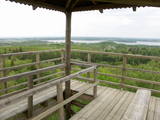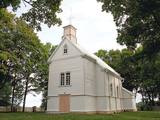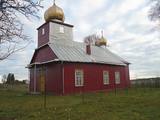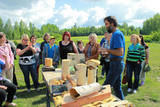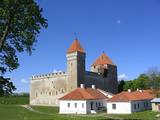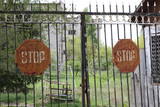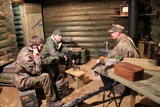| Нo | Название | Описание |
|---|---|---|
|
This grand hiking tour is provided for experienced hikers wishing to walk along a large part of the coasts of Latvia and Estonia, gain a detailed impression about the diverse coastal landscape, nature, birds and animals of the Baltic Sea. The Baltic Coastal Hiking Route sometimes runs through sandy beaches, sometimes along sections of beach covered in stones and pebbles. Sometimes the trail goes through coastal forests or stops at a fishermen’s village. There are many floodplain meadows, lagoons and shallow bays on the Estonian side, so sometimes the path goes along coastal trails and roads. In the end section of the route you will feel Estonia’s Nordic nature more. Part of the route runs along a sparsely populated seashore where you can be alone with yourself, but you will also be able to visit the most prominent cities. You will visit both capitals: Rīga and Tallinn. Enjoy the hospitality of the resort towns of Jūrmala, Pärnu and Haapsalu. During the hike, you will also get acquainted with the regions of small ethnic cultures: the Livonians in Latvia and the inhabitants of Kihnu in Estonia. |
||
|
Beliebte und eine der ältesten Straßen in Jurmala zwischen Dzintari und Majori. Die 1,1 km lange Straße mit Wirtshäusern, Sommercafés und Souvenirladen. |
||
|
The Svene Nature Park is in the central part of the Augšzeme highlands, and Lake Svente is at its centre. This is one of the cleanest lakes in Latvia. There is also Egļukalns Hill, which offers one of the most beautiful views in all of Zemgale from its viewing tower. Visitors can gaze at the hillocks and lakes of the Svente area. Egļukalns Hill also has ski trails and a nature trail. |
||
|
Хозяйка усадьбы встречает посетителей, нарядившись в национальную одежду, эдукационное занятие ведет на жямайтийском языке. Она рассказывает о травах, предлагает насобирать их, самим приготовить свой чай. К чаю предлагает сыр, хлеб, пирог, мёд, приготовленные собственноручно. Усадьба находится у озера Бержорас и недалеко от озера Плателяй. Отсюда удобно начать путешествие по Жямайтийскому национальному парку пешком, на велосипедах, плавучими средствами, а также автомобилем. |
||
|
This viewing tower is on a narrow peninsula among Lake Lukna, Lake Višķi, and Lake Boltars. From it, you can see all three lakes, the hillocks of the area, as well as Ambeļi and Višķi. Come here when the bird-cherry trees are in bloom!
|
||
|
Пушский Римско-католический костёл Пресвятой Троицы
был построен в 1743 году на средства помещика Шадурскиса и
передан на попечение иезуитов. Пушский приход был основан в
Миссии иезуитов (миссией Шадурскиса). Костёл имеет три
алтаря и орган латышского органостроителя Я. Гремзе.
|
||
|
Очень интересный памятник истории рыболовства. Лодочные причалы - когда-то пристани для рыбацких, где рыбаки строили хижины сетей и хранили свой инвентарь. Лодочные причалы играли и социальную роль - здесь собрались мужи, рассуждали о дальнейшей работе, а жены и дети плели сети. В ходе времени хижины для сетей лодочных причалов Бигауньциемса подмыты в море, а лодочные причалы Рагациемса - частично погибли. Находящиеся в Лапмежциемсе сохранились лучше всего. Одна из хижин для сетей восстановлена, но остальные находятся в очень плохом состоянии. Это может быть причиной тому, почему, идя вдоль берега моря, им следует уделить внимание и сделать какое-то «историческое» фото. |
||
|
Корчма находится в историческом центре Лимбажи, на площади Карля Блайманя. Латышская кухня: Холодный суп, жареная треска или камбала, мясной – грибной горшочек, блины с начинкой, слойка из черного хлеба, клубничный суп. Особое блюдо: «Свадебный карбонад» (из свинины). |
||
|
Предлагают размещенный в выработанном карьере пляж с площадкой для отдыха. Две волейбольные площадки, качели, батуты, надувные аттракционы. К радости для самых маленьких имеется «лягушатник». В отдельном карьере предлагается рыбалка - форель, карп, палия, сом. Здесь же на месте можно и приготовить рыбу – поджарить, сварить уху. Для приготовления рыбы предлагаем все необходимое. Рыбалка - круглый год. |
||
|
Недалеко от Рижской окружной дороги на правом берегу Даугавы находится памятник-памятный знак скульптора Г. Бурвиса, открытый в 1994-м году. Он посвящен Даугавским ливам и их предводителю Ако, который в 1206-м году возглавил борьбу против крестоносцев. В окрестностях памятника вдоль берега Даугавы создано место для отдыха и прогулок. Это одно их живописнейших мест по берегам низовья Даугавы. Немного дальше на берегу реки установлены информационные стенды, отражающие историю берегов Даугавы до строительства Рижской ГЭС. |
||
|
Моленная Нотренской старообрядческой общины. Построена
в 1928 – 1931гг. вместо старой, которая была возведена в 1853
году.
|
||
|
If you enjoy an active lifestyle, then this tour is the perfect way to enjoy the heritage hidden in Gauja National Park, from several different perspectives. Cycling starts at Strenči and passes two local breweries at Brenguļi and Valmiermuiža with nice cafés and good beer. You will hike through beautiful forests and along the Sietiņiezis sandstone cliff towards Cēsis with its charming medieval Old Town. Canoeing takes place from Cēsis to Līgatne, which is one of the nicest parts of the River Gauja with its sandstone banks, remote farmsteads and old fashioned water-powered ferry. Līgatne historic centre is connected with the development of its paper mill. Here you can also visit local wine and handicraft producers located in one of the artificial caves typical of the area. Walk the Līgatne Nature Trails to see local wild animals in a forest setting. At the end you will cycle from Līgatne to Sigulda, which is one of the most popular tourist sights in Latvia. You'll see the Turaida and Sigulda medieval castles, Gutman’s Cave and other picturesque views. |
||
|
Из натурального, самими выращенного или купленного у местных крестьян сырья, по методам предков делают яблочное, ревеневое и черносмородиновое вино и черносмородиновый спирт. Во время экскурсии можно познакомиться с процессом приготовления напитков, продегустировать и купить уже готовые продукты в магазинчике хозяйства. |
||
|
Tāšu meistars Jurijs Ivanovs ar lielu centību un degsmi pēc seniem paraugiem cenšas atjaunot labākās Zilupes novada tāšu apstrādes tradīcijas. Top novadam raksturīgi autentiski tāšu trauki ķiploku, putraimu, saldumu, sāls uzglabāšanai, paliktnīši kafijas krūzei vai pannai. Īsts meistarstiķis ir darbarīku rokturu izgatavošana. Darbnīcā varēsiet izgatavot tāšu glezniņu, tāšu tauri, uzrakstīt īpašu vēstuli kādam ļoti mīļam cilvēkam. |
||
|
История каменного замка уходит к 13-ому веку . В подвальных залах замка постоянные выставки, которые представляют природу и историю Сааремаа. В замке с мая по август действуют ремесленные мастерские (кузница, обработка стекла, гончарная мастерская, обработка камня), предлагая гостям как усладу для глаз , так и радость творчества для рук. Интерес представляет и расположенный поблизости тир для стрельбы из лука, где после попадания в цель можно самому чеканить монеты. Из филиалов Сааремааского музея советуем посетить хутор-музей Михкли на западе Сааремаа (деревня Вики, волость Кихельконна; +372 454 6613, www.saaremaamuuseum.ee), где можно увидеть как архитектурные достопримечательности, так и объекты культурного наследия. |
||
|
Atrodas Vecpiebalgas centrā pie Inešu ceļa. Vieta, kas jāapmeklē katram savas valsts patriotam, jo šeit atdusas leģendārā romāna "Mērnieku laiki" autori - brāļi Reinis un Matīss Kaudzītes, sabiedriskais darbinieks un valodnieks Atis Kronvalds u.c. Kapos apskatāmi brāļu Kaudzīšu un A. Kronvalda pieminekļi. Tos atrast palīdzēs izvietotās kartes un norādes. |
||
|
Скрундский военный городок – сегодня это недоступный и охраняемый объект, но заслуживает упоминания, так как здесь находится известный Скрундский локатор, взорванный после восстановления независимости Латвии. !!! С марта 2018 года Скрундский военный городок закрыт для посетителей. |
||
|
Сведения о принятии ливами православия содержались в документе, найденном во время реставрационных работ (девяностые годы прошлого столетия) на колокольне Колкской лютеранской церкви (см. далее), который находился здесь с момента строительства храма - 1885 года. В документе сообщалось, что переход ливов в православие или в так называемую царскую веру «не связан с вероисповеданием, но это служит средством, как получить земельное преимущество или наслаждение». Православный приход в 1885 году приобретает землю от барона Остен - Сакена. На ней в 1890 году строится церковь, дом священника и здание школы. Все строения сохранились до наших дней. Церковь имеет свой приход, и богослужения проводятся раз в месяц. Имеются сведения, что Колка – это единственный прибрежный поселок ливов, где в девяностых годах XIX века построили православную церковь. Церковный колокол занял свое место в 1936 году. В советское время церковь использовали как часовню, а в наши дни она играет свою первоначальную роль. |
||
|
Биологическое семейное хозяйство в Вырумаа, расположенное в Национальном парке Хаанья (Haanja rahvuspark). Хозяйство занимается разведением коз и производством козьего сыра. Здесь проводятся дегустации и экскурсии, во время которых Вы сможете увидеть, как молоко, принесенное из хлева, превращается в головку сыра. |
||
|
Pie Vidzemes šosejas pirms Melturu tilta pāri Amatai ir privātais muzejs "Mežabrāļu bunkurs". Bunkurs izveidots, lai varētu vēstīt par Nacionālo partizānu mežabrāļu cīņu laikā no 1944.-1956. gadam, kad mežos pret okupācijas varu cīnījās ap 20 000 Latvijas patriotu. Nacionālo partizānu bunkurs izveidots balstoties uz savāktajām mežabrāļu atmiņām, dienasgrāmatu pierakstiem un fotogrāfijām. Uz bunkuru ved meža taka ar informāciju par dažādiem mežabrāļu piedzīvojumiem un cīņām. Bunkura pazemes daļā apskatāmi vēsturiskie priekšmeti, kas viņus pavadīja dzīvē un cīņā. Saimnieks piedāvā pastaigu pa meža taku, kur izvietota informācija par mežabrāļiem un slēpņu spēle bērniem. Ar iepriekšēju pieteikšanos iespējams iekļūt bunkurā un apskatīt iekārtotu bunkuru ar mežabrāļu izmantoto ieroču, munīcijas un citu priekšmetu ekspozīciju. Stāstījumu papildina savāktās mežabrāļu interviju videoieraksti. Apmeklētājiem iespējams pasūtīt mednieku desiņu cepšanu lapenē pie bunkura. |
||



